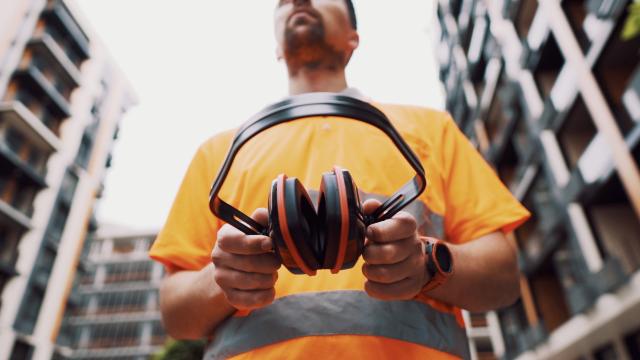If you have an iPhone and listen to music with your headphones, you’re probably familiar with the popup notification, “Volume Should Be Turned Down. Based on your headphone usage over the last seven days, you’ve exceeded the recommended limit for audio exposure.” But what is the recommended limit — and how are you supposed to know if your earbuds are too loud, anyway?
It’s not easy to know, but you should. According to Harvard Medical School, the ears have thousands of cells in them, some of which have little hairlike structures that transmit sound from your ears to your brain. Excess sound can permanently damage them, which impacts that sound transition. Simply put, listening to too much too-loud audio can damage your hearing.
How loud is too loud?
A chart from Yale gives a few examples to help you understand how decibels work: A quiet natural area with no wind has a sound level of about 20 decibels, for instance; a household refrigerator has about 55; a telephone dial tone has around 80; and a power mower sits around 107. Of course, these are all dependent on how close you are to the source of the noise — but that’s what makes headphone exposure so intense, too — the earbuds or headphones are right there on (or in) your ear.
The World Health Organisation has issued guidance saying that 80 decibels for 40 hours a week is the permissible time for “safe” listening, but anything higher than that in decibels reduces the amount of time that it’s safe to listen. The WHO has also said that the output of most personal audio devices ranges from 75 to 136 decibels.
How to check if your headphones are too loud
Your phone can tell you a lot about how loud your music is. Opening an iPhone’s Health app, for instance, reveals a lot of your decibel-related data. I was exposed to 43 minutes of 100-decibel music this week, and per minute I averaged between 71 and 102 decibels, which is not great for my long-term hearing.
The good folks at Headphonesty put together a quick list of ways you can check if your headphones are “too loud” without dealing with pesky, confusing decibel numbers. They include these:
- Put in foam earplugs and head somewhere peaceful after taking a two- to three-day break from headphones. Put your earplugs in and focus on your hearing. You’ll hear a light ringing, which is your baseline level. Use your headphones the next day and redo the test in the evening. If the ringing is louder than it was the first time, your headphones may be too powerful.
- Hold your headphones in front of you at arm’s length while music plays. If you can hear the music from that distance, the headphones are too loud.
- Actively work to keep your audio device’s volume at around its 60% capacity. If you keep inching the volume up, you’re accustomed to listening too loud.
If you experience symptoms like ringing, clicking, or buzzing in your ears, difficulty hearing at rowdy venues, hearing sounds in a muffled way, or an increased need to keep cranking your volume, you may be showing some early signs of hearing loss. Check in with an audiologist and remember to keep turning your music down.

Leave a Reply
You must be logged in to post a comment.